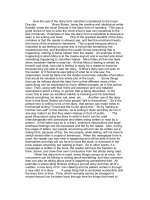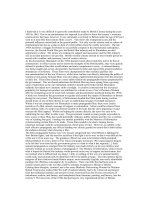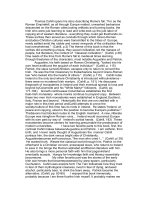How the way we talk can change the way we work seven languages for transformation
Bạn đang xem bản rút gọn của tài liệu. Xem và tải ngay bản đầy đủ của tài liệu tại đây (932.38 KB, 255 trang )
How the Way We Talk Can Change
the Way We Work
How the Way We
Talk Can Change
the Way We Work
Seven Languages
for Transformation
Robert Kegan
Lisa Laskow Lahey
Copyright © 2001 by Robert Kegan and Lisa Laskow Lahey.
Robert Frost’s “Fire and Ice” is reprinted from The Poetry of Robert Frost, edited by Edward
Connery Lathem, copyright 1923, copyright 1969 by Henry Holt and Co., copyright 1951
by Robert Frost. Reprinted by permission of Henry Holt and Company, LLC.
Excerpt from Daniel Goleman’s “Managing: A Constructive Criticism,” New York Times,
September 16, 1990, is reprinted by permission of The New York Times.
Excerpts from The Critical Edge: How to Criticize up and down Your Organization and Make
It Pay Off by Hendrie Weisinger, copyright 1990 by Perennial Library, are reprinted by
permission of Arthur Pine Associates.
No part of this publication may be reproduced, stored in a retrieval system, or transmitted in any form or by any means, electronic, mechanical, photocopying, recording,
scanning, or otherwise, except as permitted under Sections 107 or 108 of the 1976
United States Copyright Act, without either the prior written permission of the Publisher
or authorization through payment of the appropriate per-copy fee to the Copyright
Clearance Center, 222 Rosewood Drive, Danvers, MA 01923, (978) 750-8400, fax (978)
750-4744. Requests to the Publisher for permission should be addressed to the
Permissions Department, John Wiley & Sons, Inc., 605 Third Avenue, New York, NY
10158-0012, (212) 850-6011, fax (212) 850-6008, e-mail:
Jossey-Bass books and products are available through most bookstores. To contact
Jossey-Bass directly, call (888) 378-2537, fax to (800) 605-2665, or visit our website
at www.josseybass.com.
Substantial discounts on bulk quantities of Jossey-Bass books are available to
corporations, professional associations, and other organizations. For details and
discount information, contact the special sales department at Jossey-Bass.
Manufactured in the United States of America on Lyons Falls Turin Book.
This paper is acid-free and 100 percent totally chlorine-free.
Library of Congress Cataloging-in-Publication Data
Kegan, Robert.
How the way we talk can change the way we work: seven languages for
transformation / Robert Kegan, Lisa Laskow Lahey.
p. cm.
Includes bibliographical references and index.
ISBN 0-7879-5535-3 (alk. paper)
1. Change (Psychology) I. Lahey, Lisa Laskow, date. II. Title.
BF637.C4 K44 2000
155.2'5—dc21
00-010984
FIRST EDITION
HB Printing
10 9 8 7 6 5 4 3 2 1
Contents
Acknowledgments
ix
Introduction: What Do You Really Want . . . and
What Will You Do to Keep from Getting It?
1
Part One: The Internal Languages:
Building the New Machine
1
2
3
4
From the Language of Complaint
to the Language of Commitment
13
From the Language of Blame to the
Language of Personal Responsibility
33
From the Language of New Year’s Resolutions
to the Language of Competing Commitments:
Diagnosing the Immunity to Change
47
From the Language of Big Assumptions That
Hold Us to the Language of Assumptions We Hold:
Disturbing the Immunity to Change
67
Part Two: The Social Languages:
Maintaining and Upgrading the Machine
5
6
7
11
89
From the Language of Prizes and Praising
to the Language of Ongoing Regard
91
From the Language of Rules and Policies
to the Language of Public Agreement
103
From the Language of Constructive Criticism
to the Language of Deconstructive Criticism
121
vii
viii
CONTENTS
Part Three: Carrying on the Work
147
8
Running the Internal Languages
149
9
Running the Social Languages
187
Epilogue: Toward the Transformation Highway:
Transcending the Limits of the Information Age
229
The Authors
235
Index
237
Acknowledgments
We are deeply grateful to the thousands of people who have participated in the learning sessions that have led to this book, and
especially to those who consented to have their experiences recounted here; for the love and generosity of our family members,
Bill, Zach, and Max Lahey; Barbara Wolf, Lucia, and Josh Kegan;
and to the following colleagues whose thoughtful and encouraging responses to earlier drafts helped us make a better book:
Michael Basseches, William Drath, Catherine Fitzgerald, Ann Fleck
Henderson, Robert Goodman, Gina O’Connell Higgins, Michael
Jung, Emily Souvaine Meehan, Gil Noam, Laura Rogers, Christina
Schrade, Elizabeth Speicher, James Wendler.
Emily Souvaine Meehan was especially helpful in revisions of
Chapter Eight, and we owe the metaphor of the immune system to
Michael Jung, who enhanced our own discourse. Finally, we would
like to thank Karen Manning and Joelle Pelletier for their effective
preparation of the manuscript, and our editor, Alan Rinzler, for
heroic patience and wise counsel.
ix
In memory of
William Graves Perry, Jr.
How the Way We Talk Can Change
the Way We Work
Introduction
What Do You Really Want . . .
and What Will You Do to
Keep from Getting It?
The late William Perry, a favorite teacher and precious colleague
of ours at Harvard, was a gifted trainer of therapists, counselors,
and consultants. “Whenever someone comes to me for help,” he
used to say, “I listen very hard and ask myself, ‘What does this person really want—and what will they do to keep from getting it?’”
This is a book about the possibility of extraordinary change in individuals and organizations. It locates an unexpected source of
boundless energy to bring these changes into being.
As Bill’s wry words suggest, if we want deeper understanding of
the prospect of change, we must pay closer attention to our own
powerful inclinations not to change. This attention may help us discover within ourselves the force and beauty of a hidden immune
system, the dynamic process by which we tend to prevent change,
by which we manufacture continuously the antigens of change. If
we can unlock this system, we release new energies on behalf of
new ways of seeing and being.
As developmental psychologists bringing the field of adult
learning to organizational life, we are best known for championing the idea that there is life after adolescence; that our mental development, unlike our physical development, does not have
to end at age twenty; that we can keep growing and developing in
adulthood (and not just put on weight). A rich mix of professional
groups—educators and administrators at all levels, managers and
management consultants, physicians, psychotherapists, judges,
1
2
HOW THE WAY WE TALK CAN CHANGE THE WAY WE WORK
and clergy—have afforded us unusual access to their deep-down
inner purposes and puzzles. So when we are asked to consult or
give counsel, it is nearly always because people know our focus is
on the deeper, underlying changes in the way individuals and
groups make meaning, rather than aiming for the immediate relief of symptoms or behavioral strategies to bring about short-term
solutions.
Yet for all our occupational and preoccupational interest in the
possibilities of transformation, we have developed a simultaneous
fascination and respect for another aspect of our being, which can
have the effect of preventing change. We have concluded that this
dimension is not well understood in terms of “resistance,” or “denial,” or “fears,” or “defensiveness,” or “the shadow side of personality.” Of course, each of these accustomed understandings
triggers a stance—typically with unhelpful effects—regarding this
very aspect of our being: people tend to say “How can we break
down resistance—our own or that of others? How can we overcome
our defensiveness? Reduce our fear?” And so on. In this book, by
means of a new technology for learning (a “mental machine,” in
essence), we invite you into a novel and deeper understanding of
this aspect of our being, one that is more respectful and consequently a more promising support to the miracle of individual and
organizational change.
This book is for people interested in the possibility of their own
transformational learning, as well as for people interested in supporting the transformational learning of others. We consider the
second activity—widely practiced by helping professionals—an increasingly necessary feature of effective leadership, since nearly all
leaders, in as dynamic a world as our own, are called upon to lead
processes of change.
Leadership is a much more widely distributed and frequented
activity than we are often given to believe. For every chief executive presiding at the top of some organization or enterprise, there
are a thousand men and women called upon to exercise temporary or sustained leadership over a project or team within an organization. For every person assuming leadership because he or
she sought to, planned to, and now does so as an extension of a
long-crafted self-identity, there are countless others who lead because they were asked to; because “well, somebody has to”; because
INTRODUCTION
3
they were carried along, unsuspecting, by the momentum of their
own interests, commitments, loyalties, and relationships.
However we come to find ourselves in these leadership roles,
we are soon confronted with a set of daunting recognitions:
• Leading inevitably involves trying to effect significant changes.
• It is very hard to bring about significant changes in any human
group without changes in individual behaviors.
• It is very hard to sustain significant changes in behavior without
significant changes in individuals’ underlying meanings that
may give rise to their behaviors.
• It is very hard to lead on behalf of other people’s changes in
their underlying ways of making meaning without considering
the possibility that we ourselves must also change.
Of course, we are not always aware of these as distinct and explicit principles. More often they show up as one conglomerate
conclusion: despite our best efforts to lead for change, and sometimes even in spite of the sincere intention many of us have to
change, very little significant change actually occurs!
This book is aimed at understanding better—and moving beyond—this discouraging conclusion. To help us do so, it introduces
a “new technology” for personal learning. We do not use this overly
familiar word to elicit the bells and whistles of the digital age (no
PowerPoint presentation, no edge-of-the-seat suspense as to whether
the next overhead will zoom in from the left or right side of the
screen). Rather, we use it to recover its literal Greek origin, techne,
which suggests the artful or skillful activity of making or building.
We intend to help you build something in this book that can alter
your relationship to change. This new technology is rooted in appreciation of three powerful forces in nature, which we briefly describe next.
When it comes to forces of nature, the most widely addressed
and understood is what physicists call entropy, the process by which
dynamic systems (such as people, organizations, automobiles, or
solar systems) gradually fall apart. Entropy names the motion of
increasing disorder, randomness, or dissipation of energy. Our bodies, our cars, our solar system, and of course our organizations are
all wearing down. We could read Robert Frost’s words in “Fire and
4
HOW THE WAY WE TALK CAN CHANGE THE WAY WE WORK
Ice” as an unconscious ode to entropy, wondering whether the
earth will meet its end by a fiery collapse of its gravitational orbit
or by the extinction of the sun itself—two fatal entropic processes,
to be sure:
Some say the world will end in fire
Some say in ice . . .
I hold with those who favor fire
but if I had to perish twice . . .
I know that for destruction ice
is also great
and would suffice.
Despite Frost’s blasé attitude toward the prospect of being
burned to a crisp or frozen into a block of ice, it seems unlikely
that his heirs, some millions of years from now, will regard either
prospect—should one eventually appear imminent—with quite the
same equanimity. This brings us to consider two other, less well understood but equally important forces in nature.
Automobiles and solar systems cannot improve upon themselves, but people can. We can imagine, for example, that our fellow humans at some future time might spend generations in
extraordinary action to depart the earth, were it to become clear
that human life is eventually unsustainable here. Our orbit could
be in decay, or the solar engine might well one day exhaust its fuel.
But in the midst of these entropic processes we have the potential
to organize ourselves at a whole new level of complexity, to become
more ordered, to concentrate greater energy in our way of living
that might permit us an extraordinary solution to our problem.
This is the very opposite of entropy, what physicists call negentropy. Our bodies are running down, but at the same time, with
good luck and effective supports, our minds might be “running
up.” Our eyesight is deteriorating; we need corrective lenses as we
age. But at the same time, our capacity to see into our situations and
ourselves may become more acute; we may be able to discard previous psychological lenses of distortion or myopia. It is a distinguishing and heroic feature of living things that they participate
not only in deteriorative processes of declining complexity, order,
choice, concentration, and power but also in processes that lead
INTRODUCTION
5
to greater complexity, order, choice, concentration, and power.
“We will never be able to solve our problems,” Einstein said, “at the
same order of complexity we used to create our problems.”
Yet any of us who have deliberately sought to solve a significant
problem—our own or that of some group we have sought to lead—
knows it is no easy thing to set into motion the negentropic processes necessary to “solve our problems.” We have the capacity to
take extraordinary action at the individual or collective level, and
yet more often we do not. The earth is not presently in danger of
being incinerated by the sun, but it is in danger of being incinerated several times over by our own nuclear weapons. Human beings have never in their history constructed weapons they did not
eventually use. We know this. Detonating these weapons would
constitute a global entropic apocalypse. Disarming them would, as
Einstein suggests, require a negentropic leap into some saving new
way of reimagining our global conflicts.
Yet most important for the work we are about to undertake in
this book, what we have today is neither detonation nor disarmament; neither the entropic nor the negentropic. This brings us to
a third force in nature: the processes of dynamic equilibrium,
which, like an immune system, powerfully and mysteriously tend
to keep things pretty much as they are.
The forces that tend to keep things as they are may be a much
greater player in the prospects of change than is commonly understood. Many leaders work toward accomplishing significant
change—that is, negentropic change that moves their group or
organization to a new level of capacity or complexity. Other leaders worry about their organizations losing their competitive edge
and running down—that is to say, succumbing to the entropic
processes of complacency, routinization, loss of focus, or dissipation of energy. But, as we hope to demonstrate in the pages ahead
(using your own experience as the focus of attention), the biggest
player standing in the way of an organization’s chances to learn
and grow might be the same force standing in the way of an individual’s chances to learn and grow: this third force we call dynamic
equilibrium.
Although it contrasts with processes of greater complexity and
greater disorder, the third force is not about standing still, about
stasis or inertia, about fixity or the lack of motion. As we are soon
6
HOW THE WAY WE TALK CAN CHANGE THE WAY WE WORK
to see, this third force is also about motion. More precisely, it is
about a system of countervailing motions that maintains a remarkably hearty balance, an equilibrating process continuously
manufacturing immunity to change. It is possible to throw all kinds
of personal and leaderly initiative at this dynamic equilibrium,
often resulting in apparent change (losing ten pounds, realigning
corporate attention), but the process of dynamic equilibrium eventually just throws out its enormous arms in response and before
long waves itself back into familiar, upright balance (we regain the
weight; the organization returns to business as usual).
There are countless books about personal change and leadership for organizational change. In one way or another, they recognize and warn against succumbing to the deteriorative drift of
the entropic current. Such books can be tremendously appealing
in championing the negentropic possibility of our moving against
the tide. But as psychologists of adult learning and adult development, we wonder whether with just these two dynamic forces we
have fashioned a sufficiently complex picture of the forces at work
in our prospects for change.
Is any effort at personal change—our own or that of others we
may seek to lead—likely to be powerful without better understanding of this third force in nature, our own immunity to
change? Specifically, is change likely without grasping how this
third force expresses itself in the unique particulars of our own
lives? And yet, one of the things that makes gaining this understanding so difficult is that we tend to be held captive by our own
immune systems. We live inside them. We do not “have them”; they
“have us.” We cannot see them because we are too caught up in
them. This is precisely why a new technology for personal learning
is needed. In this book, we present such a technology, built around
the idea of transformative “languages”; it is a technology rooted in
twenty years of research and practice as developmental educators.
How can we secure for ourselves the supports most likely to foster real change, change that actually escapes the immunizing gravity of our own dynamic equilibria and leads to new concentrations
of energy, enhanced capacity, greater complexity? How can we as
leaders for transformational learning better understand and exercise our own opportunities to create learning-rich settings for those
we are privileged to have work with us and for us?
INTRODUCTION
7
This book seeks to engage these questions by involving you directly in an immediate set of personal experiences. (You might do
well to think of the first several chapters as the reflective equivalent of an Outward Bound ropes course.) The purpose of these activities is simultaneously to promote your own personal learning
and to introduce you to a new technology designed to create
enough cognitive and emotional “thrust” that you can at least temporarily win some distance from your own dynamic equilibrium.
The building blocks for this new technology are novel language forms. Each language is a tool, transforming a customary
mental or social arrangement into a form that increases the possibility of transformational learning. The places where we work and
live are, among other things, places where certain forms of speech
are promoted or encouraged, and places where other ways of talking are discouraged or made impossible. We are referring to how
we speak to each other in public and private conversation, in
groups and informal one-on-one communication, and perhaps
most especially (at least in the beginning) with those few others
with whom we may feel the most trust and comfort.
We are also referring to how we speak to ourselves, which,
though too rarely considered, is one of our most influential and
continuous conversational venues. (Being psychologists, we can
certify that, contrary to popular lore, talking to oneself is not a sign
of being crazy; it depends on what we say to ourselves!) Here we
are emphasizing less the content of what we say than the form in
which our saying goes on. The forms of speaking we have available
to us regulate the forms of thinking, feeling, and meaning making
to which we have access, which in turn constrain how we see the
world and act in it. Some language forms concentrate more individual and social energy than others do; they provide more focus,
increase direction, and enhance capacity—in short, they may be
tools toward negentropy. We know this may seem a rather abstract
idea at the moment, but before long you will have a direct experience of seven qualitatively different language forms—internal and
interpersonal languages—that, taken together, we believe increase
the possibilities of our ongoing unfolding. In our experience, these
novel language forms do not spring up on their own. They require
intention and attention. A good gardener must plant them and
help them grow.
8
HOW THE WAY WE TALK CAN CHANGE THE WAY WE WORK
This premise that work settings are language communities
brings us to a corollary premise: all leaders are leading language
communities. Though every person, in any setting, has some opportunity to influence the nature of the language, leaders have
exponentially greater access and opportunity to shape, alter, or
ratify the existing language rules. In our view, leaders have no
choice in this matter of being language leaders; it just goes with
the territory. We have a choice whether to be thoughtful and intentional about this aspect of our leadership, or whether to unmindfully ratify the existing drift of our community’s favored
forms. We have the choice to make much of the opportunity, or
little. We have the choice to be responsible or not for the meaning of our leadership as it affects our language community. But
we have no choice about whether we are or are not language leaders. The only question is what kind of language leaders we will be.
This book can thus also be read as a kind of itinerary, arraying a
variety of ways we may wish to be more enterprising in this aspect
of our leadership.
The four chapters of Part One take you through a step-by-step
process to build a customized version of a new technology, a new
mental machine, for your own personal learning. Using four new
languages as tools, you build a technology that gradually introduces you to your own immune system, your own dynamic equilibrium, the forces that keep the immune system in place, and the
possibilities of transcending it. Each of the four transforms a customary internal psychological set or mental arrangement into a
novel form:
1. From the language of complaint to the language of commitment
2. From the language of blame to the language of personal responsibility
3. From the language of “New Year’s Resolutions” to the language
of competing commitments
4. From the language of big assumptions that hold us to the language of assumptions that we hold
Taken together, they build a mental machine. If you value this
machine, you will want to maintain it and upgrade it. The three
INTRODUCTION
9
chapters of Part Two introduce you to three more languages that
explicitly serve these purposes. The question of how we can maintain and continuously upgrade a powerful means of personal learning is important to us not only as individuals seeking what we need
for our own growth but also as leaders thinking about how to enhance dramatically the learning that goes on in our organizations.
Each language in this second part transforms a customary interpersonal, social, or organizational arrangement into a novel form,
both to support smooth operation of the new technology and to
make it continuously improvable:
5. From the language of prizes and praising to the language of ongoing regard
6. From the language of rules and policies to the language of public agreement
7. From the language of constructive criticism to the language of
deconstructive criticism
The first four chapters introduce you to mental languages and
may seem the special province of those most interested in personal
learning, while the next three chapters introduce you to social languages and may seem the special province of those most interested
in leadership. We want to be clear at the outset that we intend a
different message. On the contrary, this book can be read as an invitation to leaders—those charged with the responsibility to evaluate and often to help change the existing social arrangements—to
consider the prior realm of internal change as crucial to their efforts and hopes.
The book can also be read as an invitation to those most interested in personal learning to consider that sustained learning
of a transformational sort may require a social arrangement that
supports it. The new technology you build in this book may provide a temporary thrust from, or perspective on, your own previously captivating equilibrium, but preserving this saving distance
may require a new ongoing social arrangement, a “new language
community” of some sort—keeping in mind that sometimes a community can be as small as two or three people, and that the ability
to bring about new social arrangements is not reserved exclusively
for leaders.
10
HOW THE WAY WE TALK CAN CHANGE THE WAY WE WORK
Having thus introduced seven new languages—four to transform customary mental arrangements and three to transform customary social arrangements; four to build a new technology, three
to maintain it and upgrade it—the last two chapters speak to how
we can deepen our practice of all seven languages and carry on the
work that together we begin in this book.
Taken as a whole, the book intends to be a novel approach to
the complex subject of why there is often so much of a slip between
the cup of our own genuine aspirations for change—personally
and collectively—and the lip of so little lasting change actually occurring. Although the ideas you find here are rooted in our own
contemporary scholarship, theory building, and practice, our first
identities are as teachers. In writing this book as teachers, we have
taken inspiration from a Confucian text: “Tell me and I’ll forget;
show me and I may remember; but directly involve me, and I’ll
make it my own.”
So, get ready. It’s our plan to directly involve you, more than
to present something to you. Welcome to the process of discovery that lies ahead; we hope you’ll let us know the meaning you
make of it.
Part One
The Internal
Languages
Building the New Machine









